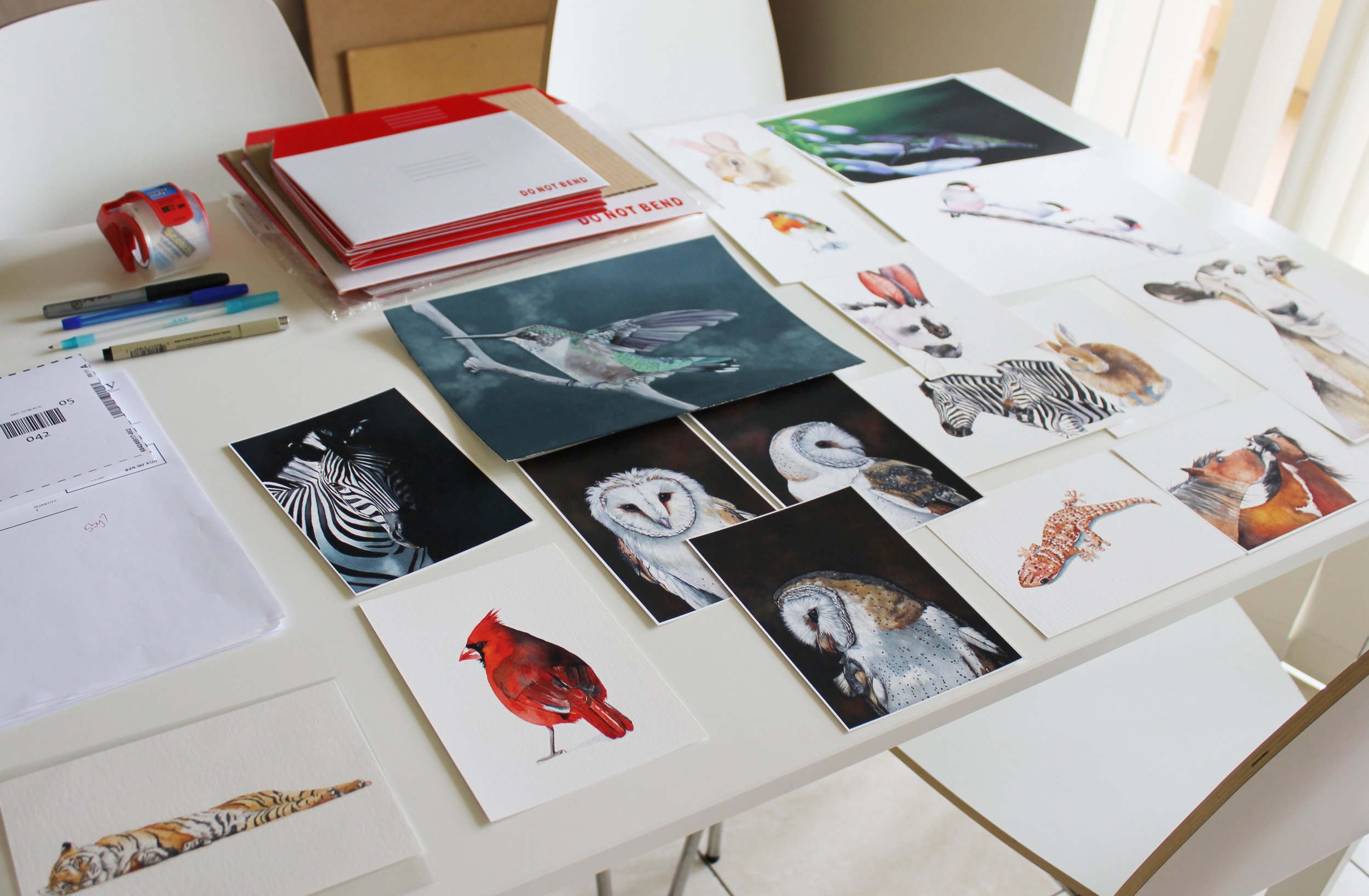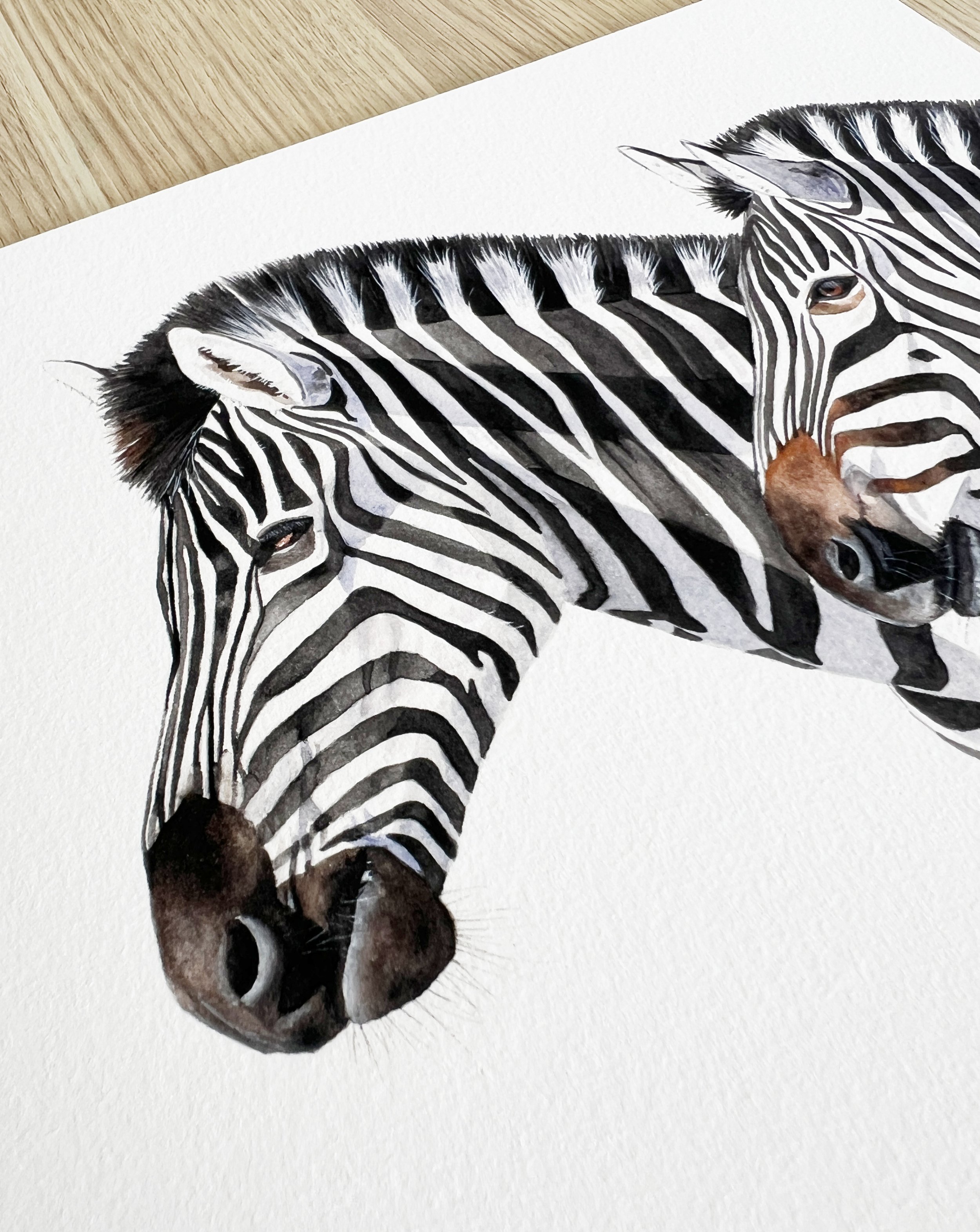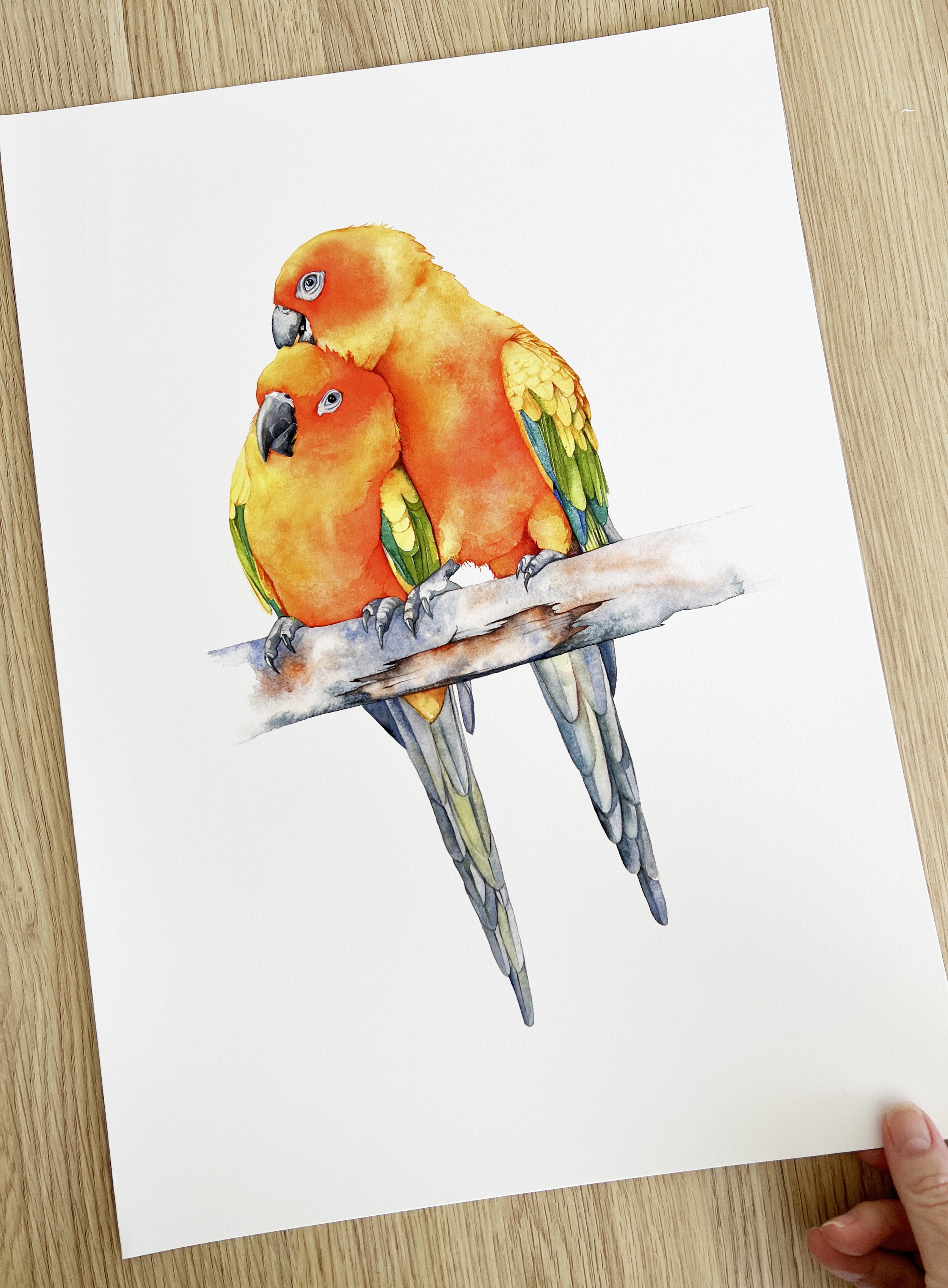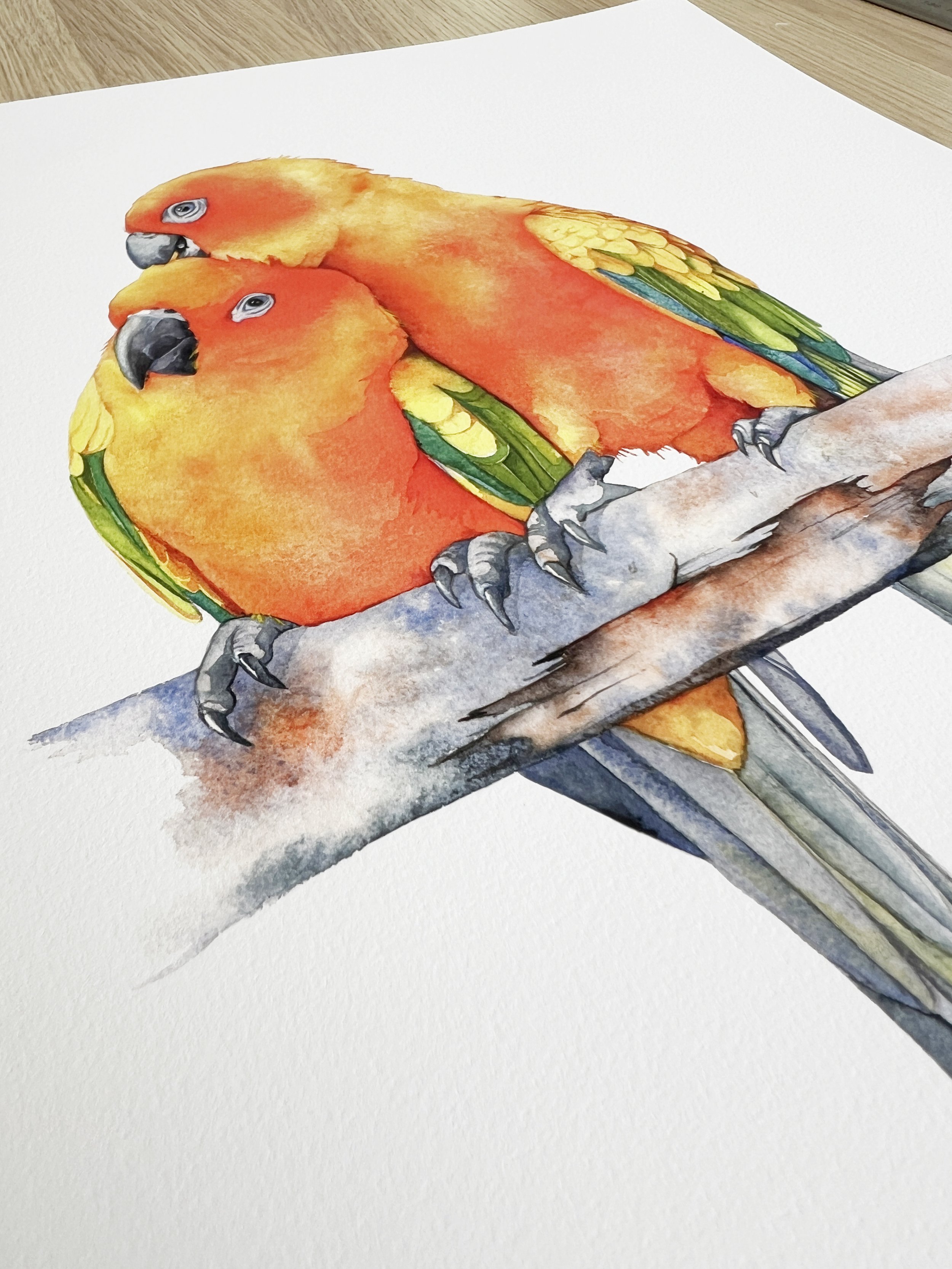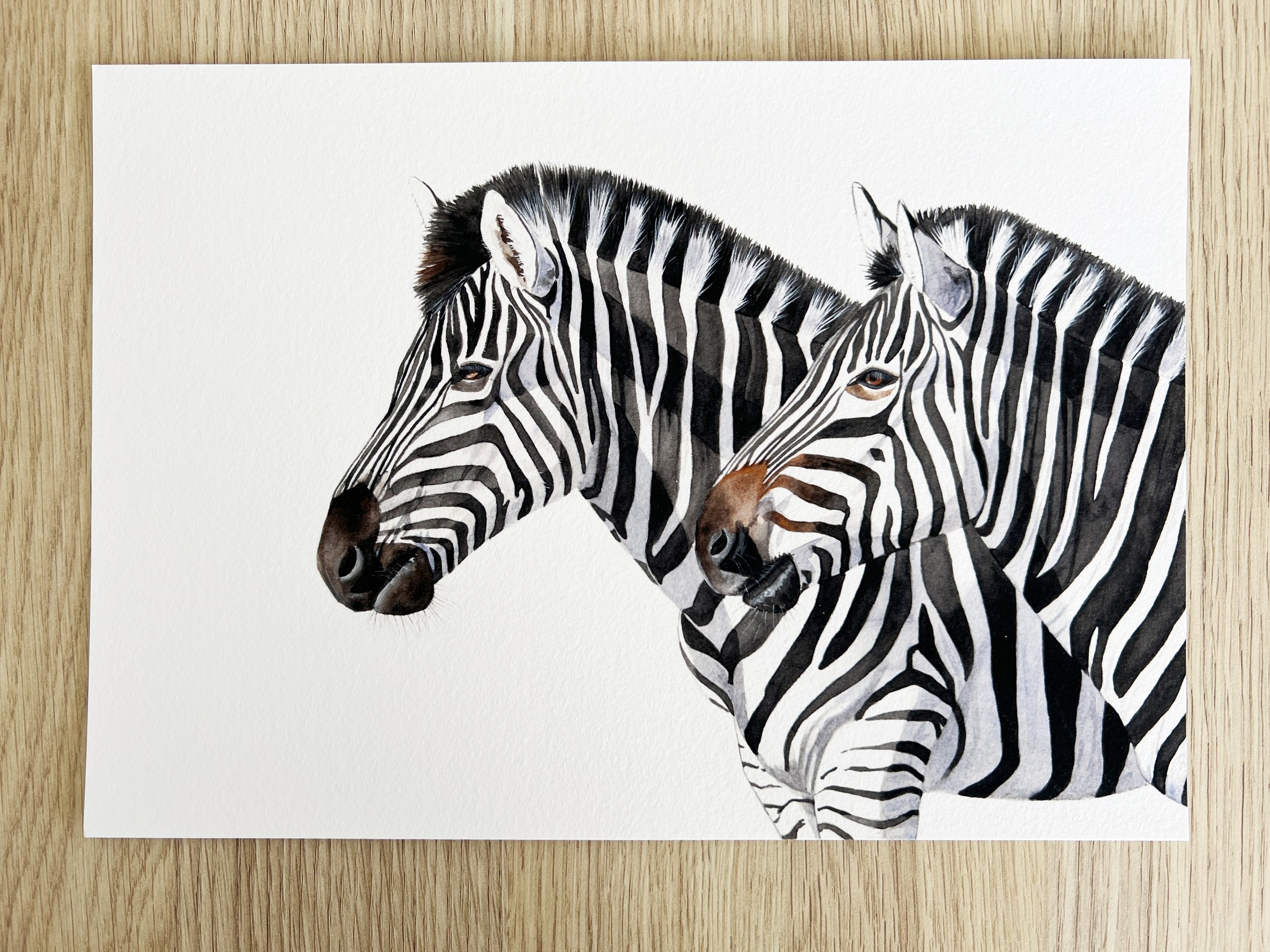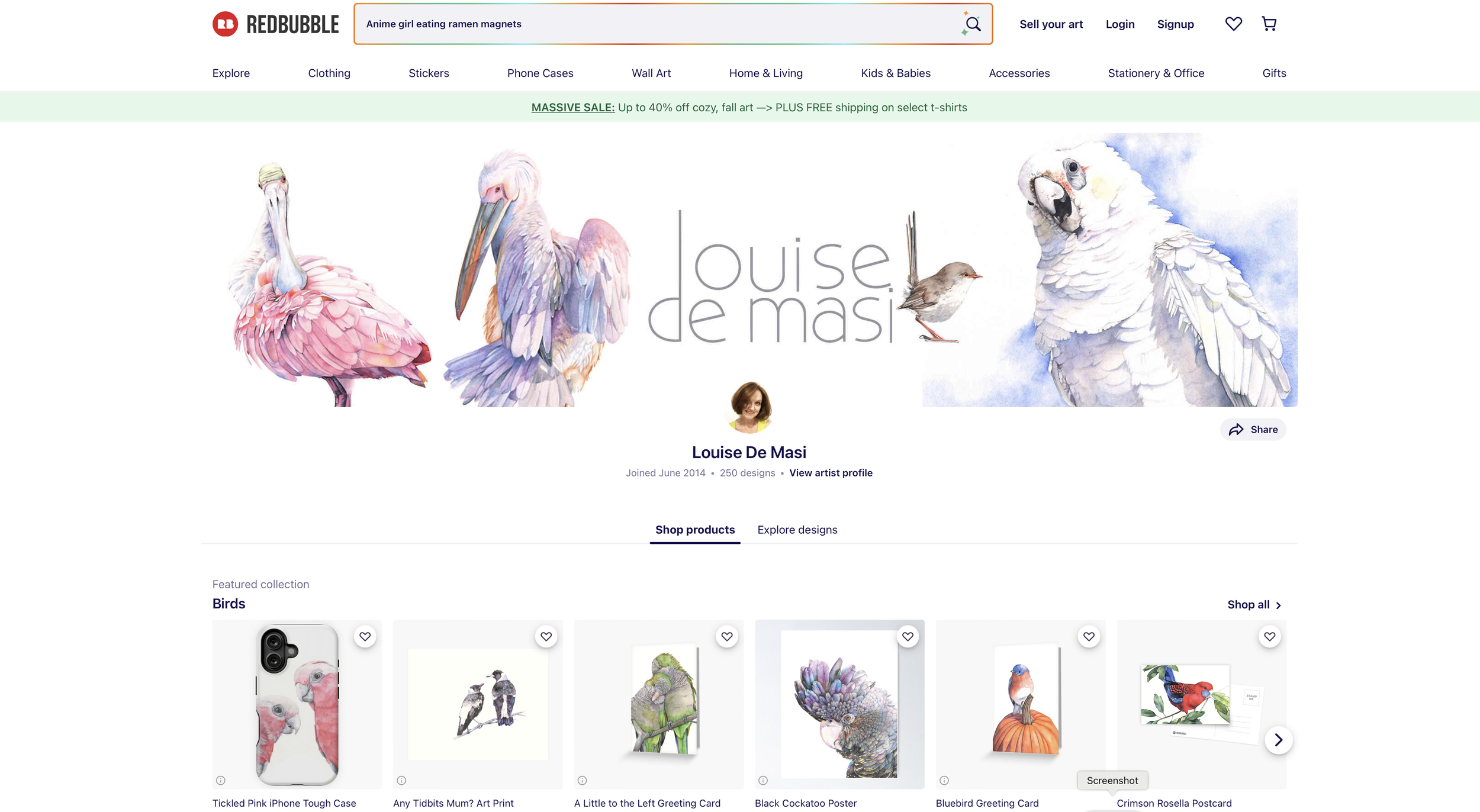Selling Your Art Prints
How to Multiply Your Art and Share Your Vision
As artists and designers, we pour our hearts and souls into every brushstroke, every hue carefully chosen, and every composition thoughtfully crafted. Each original piece is a unique reflection of our journey, emotions, and artistic vision. But what if you could multiply the impact of your art without parting with the originals? Creating art prints is a wonderful way to share your work with a wider audience, make your art more accessible, and even generate additional income to support your creative endeavours.
In this comprehensive guide, we'll delve deep into the world of art prints. We'll explore how to multiply your art, the best types of paper for high-quality prints, where to sell them, and tips to ensure your prints resonate with art lovers around the world.
This is one of my watercolour paintings that I have sold as a print.
Multiplying Your Art: The Magic of Prints
The concept of multiplying your art through prints isn't just about replication; it's about sharing your artistic journey with more people. Prints allow admirers who may not be able to afford an original piece to still own and cherish your work. It's a bridge between your original creation and the art enthusiasts who connect with it.
Why Create Art Prints?
Creating art prints is one of the most empowering ways for artists to share their work with a broader audience, making your art more accessible, impactful, and sustainable. While the artistic process is often deeply personal, prints allow your creations to reach more people, enhancing both your artistic journey and your professional growth. Here are some compelling reasons to consider making prints of your work:
Accessibility
One of the most important benefits of creating art prints is making your work accessible to a wider range of people. Original pieces, while invaluable, can often be expensive due to the time, skill, and materials involved in their creation. This puts original artwork out of reach for many potential buyers, even those who deeply appreciate your work.
Prints, however, offer an affordable alternative without compromising on visual impact. High-quality prints can capture the intricate details, colours, and textures of your original piece, allowing people to enjoy and display your art in their homes, offices, or personal spaces at a fraction of the cost.
Reach
Art prints provide a unique opportunity to expand your audience far beyond your local community. When you rely solely on selling original artwork, your market may be limited to art galleries, local exhibitions, or commissions, which can restrict your visibility.
With prints, you can take your art to a global audience. By selling online or through international marketplaces, your work can reach art collectors and enthusiasts in different countries and cultures.
As your prints hang in various spaces worldwide, they can act as ambassadors for your artistic identity, sparking conversations, recommendations, and even connections with collectors and galleries who may be interested in your original work.
Preservation
Another key advantage of creating prints is preserving the integrity of your original artwork. Original pieces are often personal treasures that can be difficult to part with, especially if they hold significant emotional or creative value. By offering prints, you allow others to enjoy and appreciate your work without having to part with the original.
Preserving your originals also ensures they stay intact for future exhibitions, personal collections, or legacy purposes. For some artists, originals are kept for special collectors, future gallery shows, or even for posterity.
Income Stream
For many artists, selling prints represents an important and sustainable income stream. While original works typically sell for higher prices, they may take time to sell, and sales can be unpredictable. In contrast, prints can be reproduced and sold in multiple editions or as open editions, giving you the ability to earn a more consistent income over time.
In addition, prints allow you to capitalize on popular pieces. If a particular artwork resonates with your audience, turning it into a print gives you the opportunity to sell it multiple times, maximizing your financial return on that piece. This approach helps support your artistic practice by providing the funds needed to invest in materials, studio space, and time to create more original work.
Beyond just financial gain, selling prints helps you build relationships with buyers. Many collectors who purchase prints may eventually become interested in acquiring original works. The process of selling prints creates multiple touch points with potential clients, opening doors for future sales and commissions.
By offering prints, you're not only multiplying your art but also spreading its impact, making it part of the everyday lives of those who connect with it. You're not simply creating an object—you're sharing a piece of yourself, your creative journey, and your artistic soul with more people than you could ever reach through originals alone.
Choosing the Right Reproduction Method
Before you begin producing prints, it is essential to choose the right reproduction method to ensure your artwork is accurately represented. Each method offers unique benefits and considerations, depending on your artistic style, budget, and the market you wish to target. Let’s explore the most common reproduction methods: Giclée printing, digital printing, and screen printing.
Giclée Printing
Giclée printing, pronounced "zhee-clay," is widely considered the gold standard for producing high-quality art prints. This method involves using specialised inkjet printers that are equipped with archival-quality inks and premium papers to ensure the print’s longevity and superior colour fidelity.
Giclée printing stands out for its exceptional colour depth, making it ideal for capturing the intricate hues and subtle gradations found in fine art. Whether you are reproducing a watercolour painting, a photograph, or a piece with complex shading, the giclée process ensures that the final print mirrors the detail and richness of the original artwork. The use of archival inks means that giclée prints are not only visually stunning but also incredibly durable, with the potential to last over 100 years without fading, given the right conditions.
A poster size print of one of my paintings.
Digital Printing
Digital printing is a more cost-effective method of producing art prints, making it a popular choice for artists looking to create affordable, open-edition prints. Using standard digital printers, this method prints directly from digital files and is known for its fast turnaround times and lower production costs. Unlike giclée, digital printing doesn’t require the same level of specialised equipment or materials, which means that the cost per print is significantly lower.
However, the trade-off is in colour accuracy and detail. While digital printing can produce visually appealing prints, it doesn’t quite match the fine precision and longevity of giclée prints. This makes it better suited for artwork where colour fidelity is not the primary concern or for prints that will be sold at lower price points, such as posters or decorative prints. Additionally, digital printing works well for open-edition prints, where you might want to print in larger quantities without the pressure of ensuring each piece is an exact replica of the original.
Screen Printing
Screen printing is one of the most traditional methods of reproducing artwork and involves using a stencil, or “screen,” through which ink is pressed onto a substrate, such as paper or fabric. This method is particularly favoured for its vibrant colours and bold designs, making it ideal for artworks that emphasise graphic elements or rely on limited colour palettes.
One of the main advantages of screen printing is its ability to produce prints with a striking visual impact. The layers of ink are applied with great precision, resulting in bold and consistent colours that pop off the page.
However, screen printing can be a labor-intensive process, and it may not be suitable for detailed or colour-heavy works. The technique is best suited for prints with fewer colours and simpler designs, as each colour layer requires a separate screen. Overall, screen printing is an excellent choice for artists who want to create bold, visually striking designs with a tactile quality, or for those working in mediums like graphic design or illustration.
Choosing the right reproduction method depends on your artistic goals, the type of artwork you’re producing, and your intended market. Whether you’re looking to create high-quality, archival prints with giclée, affordable digital prints for a broader audience, or vibrant screen prints with a unique texture, understanding the strengths and limitations of each method will help ensure your art is reproduced in the best possible way.
Selecting the Perfect Paper for Your Prints
Choosing the right paper for your art prints is a critical decision that can significantly impact the final look and feel of your work. The paper you select not only affects the print's aesthetic but also its longevity, texture, and how the colours are perceived. Here are some important factors to consider when selecting paper for your prints:
Paper Quality
I use Hahnemühle German Etching Fine Art paper for my giclee prints. The paper absorbs pigment-based inks beautifully, resulting in sharp details and deep colour saturation. It is excellent for giclée printing because it brings out rich tones and subtle gradients.
The quality of the paper you use is fundamental to the overall outcome of your prints. High-quality papers not only enhance the visual appeal of your work but also ensure its durability over time.
Archival paper is essential for any artist looking to produce long-lasting prints. Archival paper is both acid-free and lignin-free, which means it won’t yellow or deteriorate over time. This type of paper is specifically designed to prevent fading or degradation, ensuring that your prints remain vibrant and intact for years to come. If you want your work to have a timeless quality, archival paper is the best choice.
Another important consideration is the weight of the paper, measured in GSM (grams per square meter). Heavier papers, typically 200 GSM or above, feel more substantial and luxurious. This weight lends a premium quality to your prints, giving them a professional and tactile richness that lighter papers may lack. If you want your prints to have a sense of substance and durability, opting for heavier paper is advisable.
Paper Texture
The texture of the paper can greatly influence the way your artwork is perceived. Different textures provide different aesthetic effects, depending on the style and feel you want to achieve with your print.
A matte finish provides a smooth, non-reflective surface that works well for prints where you want to avoid glare. This finish ensures that your artwork remains clearly visible under various lighting conditions without any distracting reflections. A matte finish is often ideal for detailed works where the subtlety of the artwork needs to be the focal point, as the absence of sheen keeps the viewer's attention on the image itself.
Printed on Canson smooth fine art printing paper.
Canson smooth fine art printing paper showing the texture.
In contrast, a textured surface such as that found in watercolour papers can add depth and character to your prints. This texture mimics the original feel of many traditional mediums, such as watercolour or pastel. The tactile quality of textured paper can make your reproductions feel more authentic, providing an added layer of engagement for viewers who appreciate the craft behind the artwork.
My favourite paper to print on is Hahnemühle German Etching is a premium fine art paper. Its weight and texture make it feel like traditional art paper while providing the stability and quality needed for professional giclée prints.
Alternatively, glossy and semi-glossy finishes enhance the vibrancy of colours, making them pop off the page. However, glossy papers can produce glare under certain lighting conditions, which may detract from the viewing experience. For artworks with bold, intense colours, glossy paper can be a good choice, but it's important to consider the potential for unwanted reflections.
Colour Tone
The colour tone of the paper can affect the overall look of your prints, influencing how the colours and details are perceived by the viewer.
A bright white paper enhances the brightness and contrast of your artwork. This type of paper is ideal if your prints feature bold, vivid colours or high-contrast designs. Bright white backgrounds make colours stand out more starkly, providing a crisp, clean look that can be striking in many forms of art.
On the other hand, a natural white paper provides a softer, more muted appearance, which is especially well-suited for vintage-style or delicate artwork. Natural white paper creates a warm, gentle background that can help soften the edges of your artwork, giving it a more classic or nostalgic feel.
Use archival mats when you frame an archival print.
Recommended Papers for Art Prints
When choosing the best paper for your art prints, it’s helpful to consider some of the industry’s top recommendations for professional-quality prints, which won't have the ink bleed all of the place:
Hahnemühle Photo Rag: This is a 100% cotton paper with a smooth surface and a matte finish. It’s widely regarded for its ability to capture fine details, making it excellent for detailed reproductions, such as watercolours or photographs.
Canson Infinity Rag Photographique: This paper offers a smooth texture combined with a bright white tone, which enhances both the colours and the fine details of your artwork. It’s a great choice if you want to maximize colour contrast while maintaining a smooth surface.
Epson Somerset Velvet: This paper features a textured surface that adds depth to your prints. It’s particularly well-suited for reproducing watercolours or other artworks where you want the texture of the paper to enhance the overall feel of the piece.
Tip: Request Paper Samples
Before committing to a particular paper, it’s always a good idea to request paper samples from your printer. This allows you to compare how your artwork appears on different types of paper and make an informed decision about which one best represents your work. Viewing your art on different papers can give you a better sense of how the colours, textures, and overall presentation of your piece will translate in print form.
Preparing Your Artwork for Printing
To achieve the best print quality, proper preparation of your digital files is essential. I have written a detailed blog post about it.
Where to Sell Your Art Prints
Once your prints are ready, the next step is to explore various platforms and venues where you can sell them. Finding the right marketplace for your prints will help you reach potential buyers and build a sustainable business. Let’s look at some of the best places to sell your art prints, both online and locally.
Online Marketplaces
One of the most effective ways to sell your art prints is through online marketplaces that cater specifically to artists and creatives. These platforms have large audiences and are designed to showcase handmade and artistic goods.
Etsy is a popular platform that allows artists to create their own shops and sell handmade and artistic goods. It’s user-friendly and enables you to reach a global audience with ease. By setting up your shop on Etsy, you can showcase your prints to people all over the world who are specifically looking for unique, artistic products.
Artfinder focuses on connecting artists with collectors worldwide. While Artfinder is known for selling original works, it also offers the option to sell prints. This platform emphasizes the relationship between artists and collectors, making it an excellent place to sell both originals and limited-edition prints.
Saatchi Art is an online gallery that promotes emerging artists. The platform allows you to sell both original artwork and limited-edition prints, and it offers artists a chance to reach a broad audience of collectors and art enthusiasts.
Print-On-Demand Services
If you prefer a hands-off approach to selling prints, print-on-demand services are an excellent option. These platforms handle production, shipping, and customer service, allowing you to focus solely on creating your art.
Society6 allows artists to upload their designs, and the platform takes care of the rest, from printing to shipping. Society6 offers a variety of products, from art prints to home goods, so you can expand your audience by offering your art in different formats.
Redbubble is similar to Society6 and provides a wide range of products on which your art can be printed. The platform also has a strong community of artists and a user-friendly interface, making it easy to start selling your prints quickly.
Print companies such as Redbubble offer print-on-demand services for customers.
Fine Art America offers a more premium selection of print options, including framing and matting services. This platform is great if you want to offer higher-end prints and give buyers the option to purchase ready-to-hang artwork.
Your Own Website
Creating your own website is another excellent way to sell your prints, offering you full control over how you present and sell your work. Using e-commerce platforms like Shopify, Squarespace, or Wix, you can design a personalized online store that reflects your brand and artistic style.
The main advantage of having your own website is that you have complete control over branding, pricing, and the customer experience. You can set your own rules, customise the look and feel of your store, and directly interact with your buyers. Additionally, having a dedicated site helps you build your own audience, which can lead to more loyal customers over time.
I can customize my website to suit my needs.
A useful tip is to incorporate a blog or newsletter into your website. By regularly sharing insights about your artistic process, upcoming projects, or your journey as an artist, you can engage with your audience on a deeper level and build a community around your work.
Social Media Platforms
Social media is a powerful tool for artists looking to sell prints. Not only can you reach a wide audience, but you can also showcase your art in real time and interact directly with potential buyers.
Instagram Shopping allows you to tag products in your posts and stories, making it easy for your followers to purchase prints directly from your feed. Instagram’s visual nature is perfect for artists, and it gives you the opportunity to build a portfolio that doubles as a shop.
Facebook Marketplace provides a way to sell directly to your followers and local community. You can list your prints for sale and manage transactions directly through Facebook, offering a simple and effective way to reach buyers.
Pinterest is another great platform for selling art prints. By using rich pins, you can link your artwork directly to your product pages, allowing users to easily purchase your prints.
Local Opportunities
In addition to selling prints online, don’t overlook the potential of selling locally. Local opportunities allow you to engage with your community, build relationships with buyers, and gain exposure in your area.
Art Galleries and Shops are great places to display and sell your prints. Partnering with local galleries or boutique shops gives you the chance to showcase your work to people who appreciate art and are more likely to invest in prints.
Art Fairs and Markets offer another avenue for selling prints face-to-face. Participating in these events allows you to meet buyers in person, discuss your work with them, and build lasting relationships.
Coffee Shops and Cafés often support local artists by displaying their work on the walls. Many establishments are willing to showcase prints for sale, and this can be a great way to get your artwork in front of a broader audience in a relaxed, everyday setting.
Interior of a coffee shop. Image by Madun Digital from Pixabay
By exploring these various platforms and venues, you can reach a diverse range of buyers and maximise the visibility of your art prints. Whether you choose to sell online, locally, or through your own website, each option presents unique advantages that can help you grow your art business.
Pricing Your Prints
Setting the right price for your art prints is crucial. You want to strike a balance between making your work accessible to a wider audience and reflecting the value of your artistic effort. Pricing should account for several factors to ensure that your prints are both affordable for buyers and profitable for you as an artist.
Factors to Consider
The first step in pricing your prints is understanding the cost of production. This includes the expenses associated with printing the artwork, the quality of the materials used (such as paper and inks), and the packaging required to safely ship your prints. Additionally, if you’re selling through an online marketplace or print-on-demand service, you should factor in any platform fees or commissions that will be deducted from your sales.
Another important aspect is the time investment involved in creating and selling your prints. While the artwork itself may already be complete, preparing the files for print, managing your online store, marketing your prints, and handling customer service are all time-consuming tasks. It’s essential to account for this time when setting your prices, ensuring that your effort is adequately compensated.
Researching market rates is also key to pricing your prints effectively. Look at similar artists within your niche and observe the price range for comparable prints. By analyzing the competition, you can ensure that your prices are competitive without undercutting your own value.
Additionally, the edition size of your prints will influence pricing. Limited edition prints, due to their exclusivity and rarity, can often be priced higher than open edition prints. Collectors are willing to pay more for a piece that feels unique or scarce, so if you’re offering a small number of prints, you can justify a higher price point.
Pricing Strategies
One common approach to pricing art prints is tiered pricing. This strategy involves offering different sizes or formats of the same print at varying price points. For example, a smaller print may be more affordable, while a larger, more premium version could be priced higher. This allows you to appeal to a broader audience, as buyers with different budgets can choose the option that suits them.
Another effective strategy is offering bundles and discounts. By encouraging customers to purchase multiple prints at once, you can increase your overall sales while providing buyers with a sense of added value. Offering bundle deals or seasonal discounts can create a sense of urgency and incentivise people to buy more prints, thus boosting your revenue while providing them with a good deal.
Legal and Ethical Considerations
When selling art prints, it’s essential to ensure that you’re operating within the legal framework and maintaining ethical standards in your business practices. By following the necessary legal guidelines and adhering to ethical norms, you protect both your artwork and your reputation as an artist. Let’s break down some of the most important legal and ethical aspects to consider.
Copyright Laws
Copyright laws are fundamental to protecting your rights as an artist. As the creator of original works, you automatically hold the copyright to your art, which means you have the exclusive right to reproduce, distribute, and sell it. By understanding your copyright rights, you can prevent unauthorised reproduction of your work, whether online or in physical form.
At the same time, it’s equally important to respect others' copyright. This means you must avoid using any copyrighted materials, such as images or designs, without obtaining the necessary permissions or licenses. Whether you’re incorporating elements into a new piece or referencing another artist’s work, always ensure that you have the legal right to do so.
Clear Policies
Another key aspect of selling art prints involves having clear, transparent policies that outline the terms of your business. A well-defined returns and refunds policy is crucial for setting expectations with your customers and avoiding misunderstandings. For example, you might clarify whether you accept returns on art prints and under what conditions (e.g., if the print is damaged upon arrival).
In addition to return policies, it's important to have a privacy policy in place, especially if you are collecting personal information from your customers (such as their names, email addresses, or payment details). Many countries and regions have strict regulations regarding the protection of customer data, such as the GDPR in Europe. Your privacy policy should clearly explain how you handle, store, and protect this information, and it should comply with all relevant data protection laws.
Taxes and Regulations
When selling art prints, especially if you’re doing so on a regular basis or at a large scale, you may have tax obligations. In many regions, you’ll be required to collect and remit sales tax on the items you sell, depending on where your customers are located. Tax laws vary by country, state, and even city, so it’s important to research the specific tax requirements in your area and in the regions where you plan to sell. Many online platforms will assist with sales tax collection, but if you are selling prints through your own website, you may need to handle this yourself.
You should also be aware of any business licenses or permits that are required to sell your art. Depending on your location, selling art prints might be considered a business activity, which could require you to register as a business and obtain the appropriate licenses. Whether you are selling online or in person (for example, at art fairs or galleries), make sure you understand and comply with any regulations that apply to your specific situation.
Final Words of Wisdom
Embarking on the journey of selling art prints is both exciting and challenging. It offers an incredible opportunity to share your passion with the world and connect with people who resonate with your work. Remember, success doesn't happen overnight. It requires patience, persistence, and a genuine love for what you do.
By carefully selecting your reproduction methods, choosing the right materials, and thoughtfully marketing your prints, you're setting the foundation for a thriving art business. Embrace the process, celebrate small victories, and continue to create art that reflects your unique voice.
Your art has the power to inspire, comfort, and bring joy to others. By multiplying your art through prints, you're not just expanding your reach - you're enriching the lives of those who experience your work.
Happy creating, and may your artistic journey be fulfilling and prosperous!
If you are interested in learning to paint in watercolour, I have over 170 online, voiced over watercolour tutorials for all skill levels.




